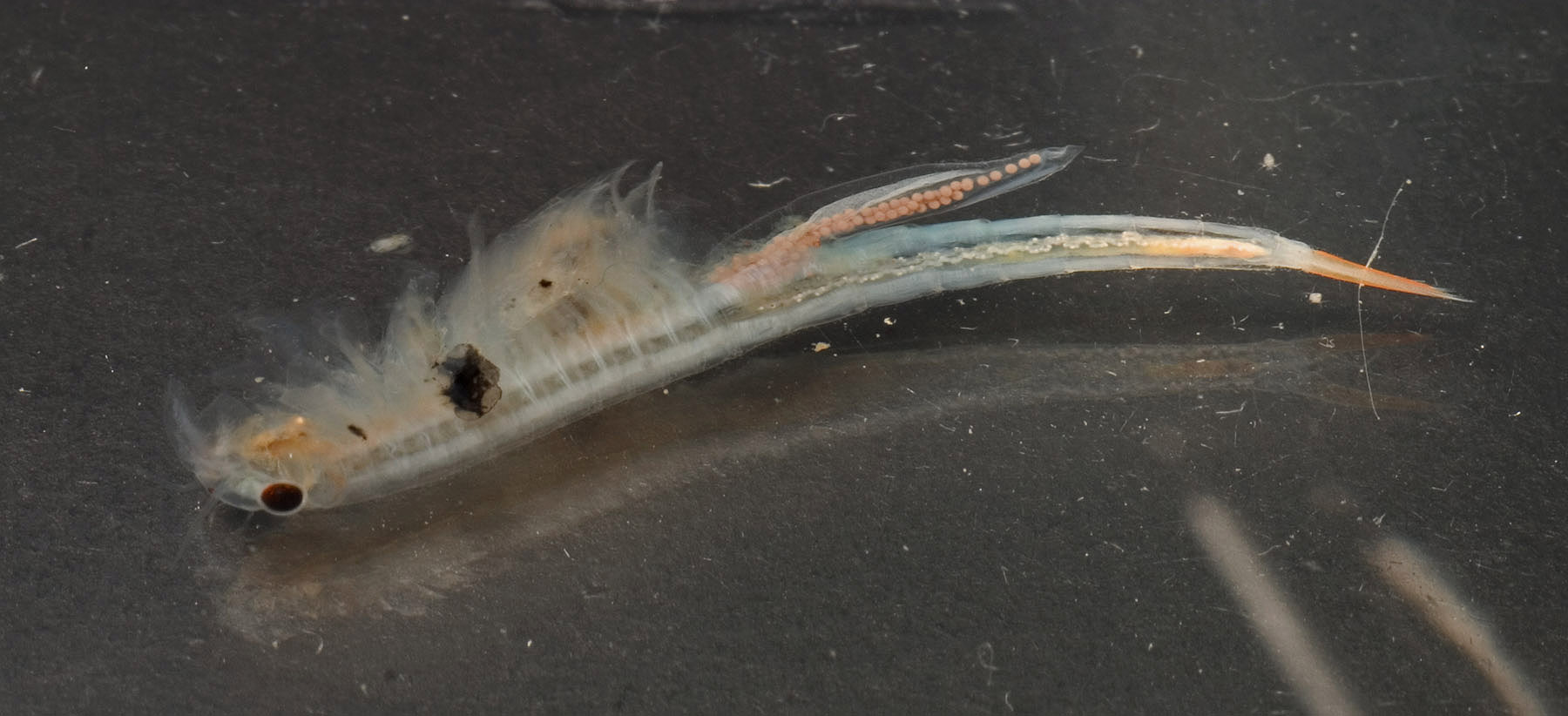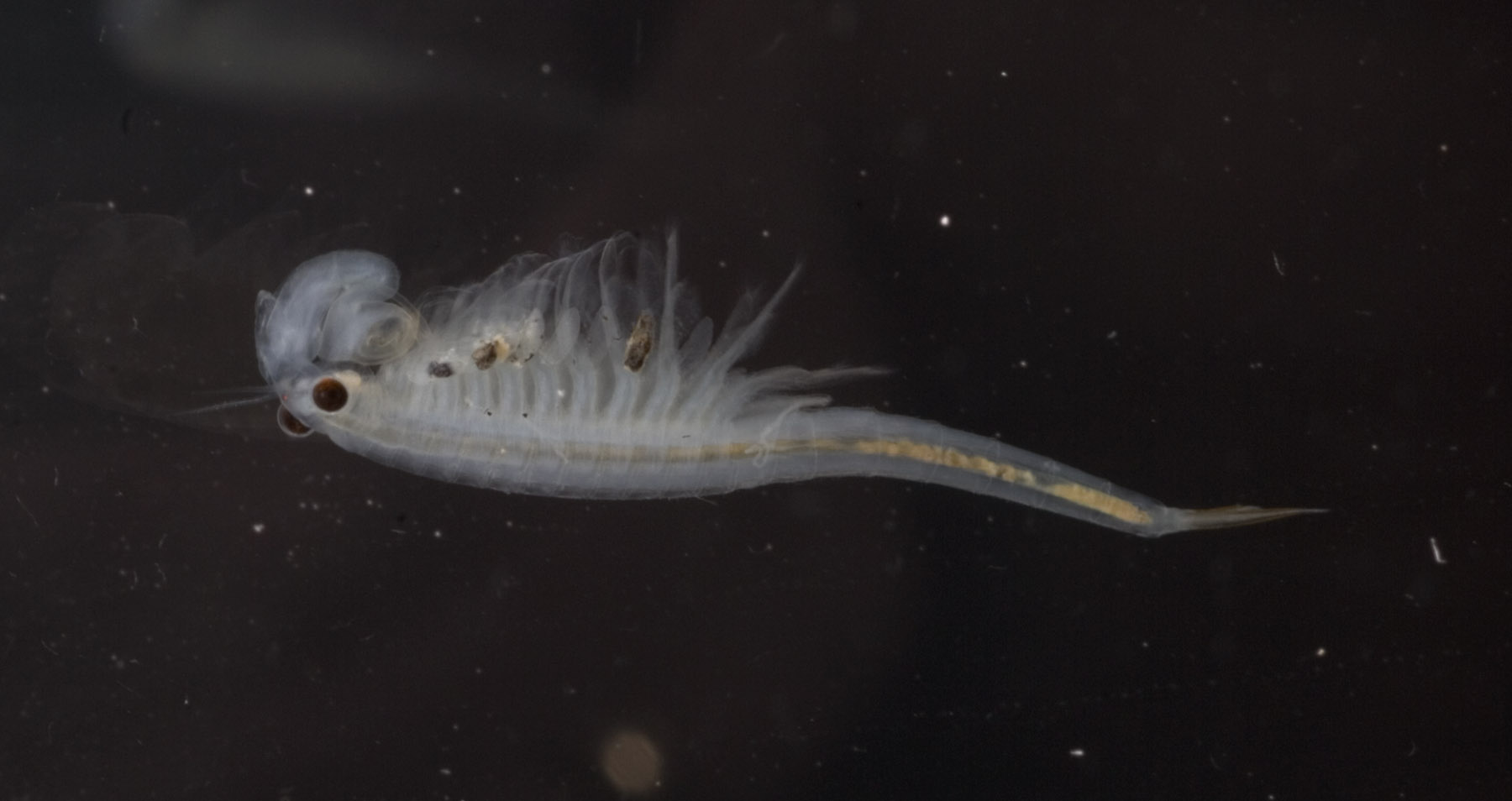Current Distribution Rangewide
There are 45 vernal pool complexes known to be occupied by the Riverside fairy shrimp in Riverside, Orange, and San Diego counties [1]. It has also been collected from northwestern Baja California, Mexico vernal pools [2].
Known Populations in San Diego County
It is known from Marine Corps Base (MCB) Camp Pendleton and from within the MSPA in MU2 (Marine Corp Air Station Miramar), MU5 (near Ramona), and MU3 (Otay Mesa) [3,4]. More than half (approximately 56%) of the known Riverside fairy shrimp populations and occupied vernal pool complexes in San Diego occur on Marine Corps Base (MCB) Camp Pendleton [1].
List Status
FE [2].
Habitat Affinities
Narrow habitat requirements and is restricted to deep lowland vernal pools that retain water for 2-8 months, and are generally 12 in (30 cm) or deeper [1]. They will not hatch in shallow vernal pools or in vernal pools that receive cooler waters from early winter rains [2]. In San Diego, Riverside fairy shrimp are found in vernal pools that are closely tied to Diablo, Huerhuero, Redding, Stockpen, Linnea, Placentia, Olivenhain, and Salinas soil series in flat to gently sloping landscapes [5].
Taxonomy and Genetics
A small aquatic crustacean in the order Anostraca [1,6]. First described in 1985 based on specimens collected from western Riverside County in 1979. There are 3 recognized species of Streptocephalus in California; S. woottoni, S. seali, S. similis [7]. The spiny-tail fairy shrimp (Streptocephalus sealii) is considered to be the most similar to the Riverside fairy shrimp [2]. The species differ in cercopod morphology and a lack of red extending into the cercopods in either sex of the spiny tail fairy shrimp [5]. Only the males in the genus Streptocephalus can be identified to the species level and the cysts can only be identified to the genus level [7].
Seasonal Activity
Fertilized eggs with tiny embryos (cyst) fall to the soil surface and remain dormant until the next wet season and the right environmental stimuli triggers hatching [7].
Life History/Reproduction
A small (0.56 - 0.92-inch (14 - 23-millimeter)) freshwater aquatic crustacean restricted to vernal pools and other non-vegetated ephemeral pools [1]. Mature males are between 0.56 in (14 mm) and 0.92 in (23 cm) in length with a cylindrical frontal appendage that is bilobed at the the tip [5]. Males are distinguished from other fairy shrimp species primarily by the second pair of antennae [7]. Mature females are between 0.56 in (14 mm) and 0.84 in (21 mm) and carry their cysts (i.e.,eggs) in an oval or elongate ventral brood sac that is visible while swimming. Both male and females have a red color to the ceropods (tail feelers) covering a portion of abdomen [5]. Cysts can hatch within 7 to 12 days of inundation [7], but they take 7 weeks to 2.5 months to reach maturity [8]. After several years of breeding, cyst “banks†develop in pool soils [9]. In any given year, only a fraction of the cysts may hatch when the pools refill during the rainy season [10]; this partial hatching of cysts helps the Riverside fairy shrimp to survive and sustain a cyst bank in an extremely variable environment [11].
Diet and Foraging
Riverside fairy shrimp are filter feeders that use their leaf like legs to feed on algae, bacteria, protozoa, rotifers, and bits of detritus while swimming upside down [6].
Dispersal
Dispersal is relatively localized and fairy shrimp within a complex have been found to be more closely related to each other than to individuals found in adjacent but not connected complexes [12]. Fairy shrimp are a food source for waterfowl (especially ducks) and are thought to also be dispersed by them as they move from pool to pool and complex to complex [1] .
Threats
Vulnerable and threatened by habitat disturbances such as; urban, road, and agricultural development; off-road vehicle (OHV) use; trash dumping; cattle trampling; human trampling; military activities; water management activities; and habitat isolation [14]. The development of an increase in border security continues to threaten Riverside fairy shrimp populations along the international border on Otay Mesa [15]. Because vernal pools are considered Riverside fairy shrimp habitat, impacts to vernal pools, complexes and the associated watersheds (i.e., destruction of vernal pools or their watersheds, and isolation of pools and fragmentation of pool systems) can result in local extirpations of this species and cutting off potential recolonization events by dispersal from nearby populations [13]. Impacts to the associated upland habitats, which provide much of the food sources (algae, diatoms, and particulate organic matter brought into pools via overland flow of rainwater) will also affect the long-term survivability of this fairy shrimp species [14]. Climate change and drought effects threaten this species by changing its distribution and abundance across the range as air and water temperatures rise and shifts in the seasonality and length of ponding result in conditions unsuitable for the Riverside fairy shrimp to complete its life cycle and depleting the cyst bank.
Special Considerations:
Not all vernal pools fill in a given year, and pools may not pond long enough for Riverside fairy shrimp to hatch [1]. Surveys may miss collecting adults due to the species' very low percentage of cyst hatching (i.e., as few as 0.18 percent) [10]. The ability to develop and maintain cyst banks is vital to the long-term survival of Riverside fairy shrimp populations [1]. They emerge later in the season than other fairy shrimp species, and therefore can be easily missed during presence/absence surveys [8]. The species is restricted to approximately 59 acres of remaining suitable habitat [14]. San Diego supports the largest number of individual occupied pools and complexes. Skunk Hollow in Riverside County, is 33 acres in size, and supports the greatest extent of occupied habitat in the species’ range.
Literature Sources
[1] U.S. Fish and Wildlife Service. 2008. Streptocephalus woottoni Riverside Fairy Shrimp 5-Year Review: Summary and Evaluation. Carlsbad, CA.
[2] U.S. Fish and Wildlife Service. 1993. Determination of Endangered Status for Three Vernal Pool Plants and the Riverside Fairy Shrimp. Federal Register 58: 41384–41392.
[3] City of San Diego. 2016. Draft Vernal Pool Management Plan.
[4] MSP-MOM. 2014. Management Strategic Plan Master Occurrence Matrix. San Diego, CA. Available: http://sdmmp.com/reports_and_products/Reports_Products_MainPage.aspx
[5] U.S. Fish and Wildlife Service. 1998. Vernal Pools of Southern California Recovery Plan. Portland, OR.
[6] Eng, L. L., D. Belk, and C. H. Eriksen. 1990. California Anostraca: Distribution, Habitat and Status. Journal of Crustacean Biology 10: 247-277.
[7] Eriksen, C. and D. Belk. 1999. Fairy Shrimps of California's Puddles, Pools, and Playas. Mad River Press, Inc., Eureka, California.
[8] Hathaway, S.A. and M.A. Simovich, 1996. Factors Affecting the Distribution and Co-occurrence of Two Southern Californian Anostracans (Branchiopoda), Branchinecta sandiegonensis and Streptocephalus woottoni. Journal of Crustacean Biology 16 (4): 669-677
[9] Ripley, B.J., J.H. Holtz, and M.A. Simovich. 2004. Cyst Bank Life-history Model for a Fairy Shrimp from Ephemeral Ponds. Freshwater Biology 49: 221-231.
[10] Simovich, M.A. and S.A. Hathaway. 1997. Diversified Bet-hedging as a Reproductive Strategy of Some Ephemeral Pool Anostracans. Journal of Crustacean Biology 17: 38-44.
[11] Simovich, M.A. 2005. Considerations for the Management of Vernal Pool Faunal Communities. U.S. Department of Agriculture, Forest Service General Technical Report PSW-GTR-195.
[12] Bohonak, A.J. 2005. Conservation Genetics of the Endangered Fairy Shrimp Species Branchinecta sandiegonensis. MSCP Vernal Pool Inventory, City of San Diego, California.
[13] Bauder, E.T. 1987. Threats to San Diego Vernal Pools and Case Study in Altered Pool Hydrology. ed. T.S. Elias, 209-213, Conservation and Management of Rare and Endangered Plants. Proceedings from a conference of the California Native Plant Society.
[14] U.S. Fish and Wildlife Service. 2012. Endangered and Threatened Wildlife and Plants; Revised Critical Habitat for Riverside Fairy Shrimp. Federal Register 77 No. 233: 72070-72140.

